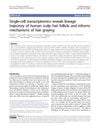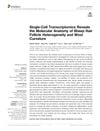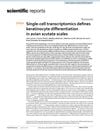Search
for
Did you mean single-cell transcriptomics?
Learn
5 / 8 resultslearn Osteopontin
signaling protein that, when suppressed, may grow hair by reducing inflammation and stem cell loss
learn Epidermal Growth Factor
learn Follistatin
glycoprotein that inhibits TGF-β and promotes hair growth by antagonizing activin
learn Thymosin Beta 4
Research
5 / 1000+ results
research Single-Cell Transcriptomics Reveals Lineage Trajectory of Human Scalp Hair Follicle and Informs Mechanisms of Hair Graying
The study found new details about human hair growth and suggests that preventing a specific biological pathway could potentially treat hair graying.

research Single-Cell Transcriptomics Reveals the Molecular Anatomy of Sheep Hair Follicle Heterogeneity and Wool Curvature
The research identified genes that explain why some sheep have curly wool and others have straight wool.

research Single-Cell Transcriptomics Reveals a Senescence-Associated IL-6/CCR6 Axis Driving Radiodermatitis
Blocking certain immune signals can reduce skin damage from radiation therapy.

research Single-Cell Transcriptomics Defines Keratinocyte Differentiation in Avian Scutate Scales
The research identified two types of keratinocytes in chicken scales: one for hard scales and another for soft skin, with similarities to human skin differentiation.
research Single Cell Transcriptomics of Human Epidermis Reveals Basal Stem Cell Transition States
Basal stem cells in the skin have distinct types that are crucial for skin structure and health.
Community Join
5 / 1000+ resultscommunity Polydopamine Synergizes with Quercetin Nanosystem to Reshape the Perifollicular Microenvironment for Accelerating Hair Regrowth in Androgenetic Alopecia.
A quercetin-encapsulated and polydopamine-integrated nanosystem (PDA@QLipo) shows promise for treating androgenetic alopecia by reshaping the perifollicular microenvironment, outperforming minoxidil in hair regeneration. The nanosystem promotes cell proliferation, hair follicle renewal, and recovery by scavenging reactive oxygen species and enhancing neovascularity.
community Scientists May Have Accidentally Found a Way to Reverse Hair Loss Without Drugs
2-deoxy-D-ribose is being explored as a hair loss treatment but is not proven effective in humans and may be costly and inconvenient. Minoxidil remains the most effective treatment.

community Compressed part of research of theory of androgenic/anabolitic balance. AGA h-responders analytic. Theory of physio-metabolitic method of anti AGA treatment
The treatment for androgenetic alopecia involves using finasteride and minoxidil with intense exercise and cold exposure to boost metabolism and reduce androgenic effects, potentially leading to hair regrowth. This approach may activate biological pathways for improved hair and overall health.
community 8 years of hair loss, turning 30 next month
The user has been dealing with hair loss for 10 years, worsened by psoriasis, and uses minoxidil and finasteride. They seek advice on managing psoriasis and hair loss, with suggestions to see a dermatologist, try different shampoos, and be patient.
community Scientists discover new T cell treatment that could regrow hair
Scientists discovered a new T cell treatment that could regrow hair. Users are skeptical but hopeful, with some relying on finasteride and minoxidil in the meantime.